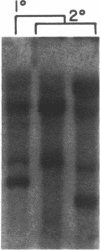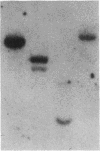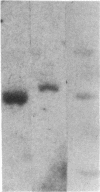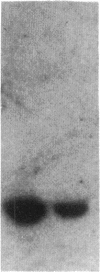Abstract
Mice were repopulated with small numbers of retrovirally marked hematopoietic cells operationally definable as totipotent hematopoietic stem cells, without engraftment of cells at later stages of hematopoiesis, in order to facilitate analysis of stem cell clonal histories. This result depended upon the use of unirradiated W/Wv newborn recipients. Before transplantation, viral integration markers were introduced during cocultivation of fetal liver or bone marrow cells with helper cell lines exporting defective recombinant murine retroviruses of the HHAM series. Omission of selection in culture [although the vector contained the bacterial neomycin-resistance (neo) gene] also limited the proportion of stem cells that were virally labeled. Under these conditions, engraftment was restricted to a small population of marked and unmarked normal donor stem cells, due to their competitive advantage over the corresponding defective cells of the mutant hosts. A relatively simple and coherent pattern emerged, of one or a few virally marked clones, in contrast to previous studies. In order to establish the totipotent hematopoietic stem cell identity of the engrafted cells, tissues were sampled for viral and inbred-strain markers for periods close to one year after transplantation. The virally labeled clones were characterized as stem cell clones by their extensive self-renewal and by formation of the wide range of myeloid and lymphoid lineages tested. Results clearly documented concurrent contributions of cohorts of stem cells to hematopoiesis. A given stem cell can increase or decrease its proliferative activity, become completely inactive or lost, or become active after a long latent period. The contribution of a single clone present in a particular lineage was usually between 5% and 20%.
Full text
PDF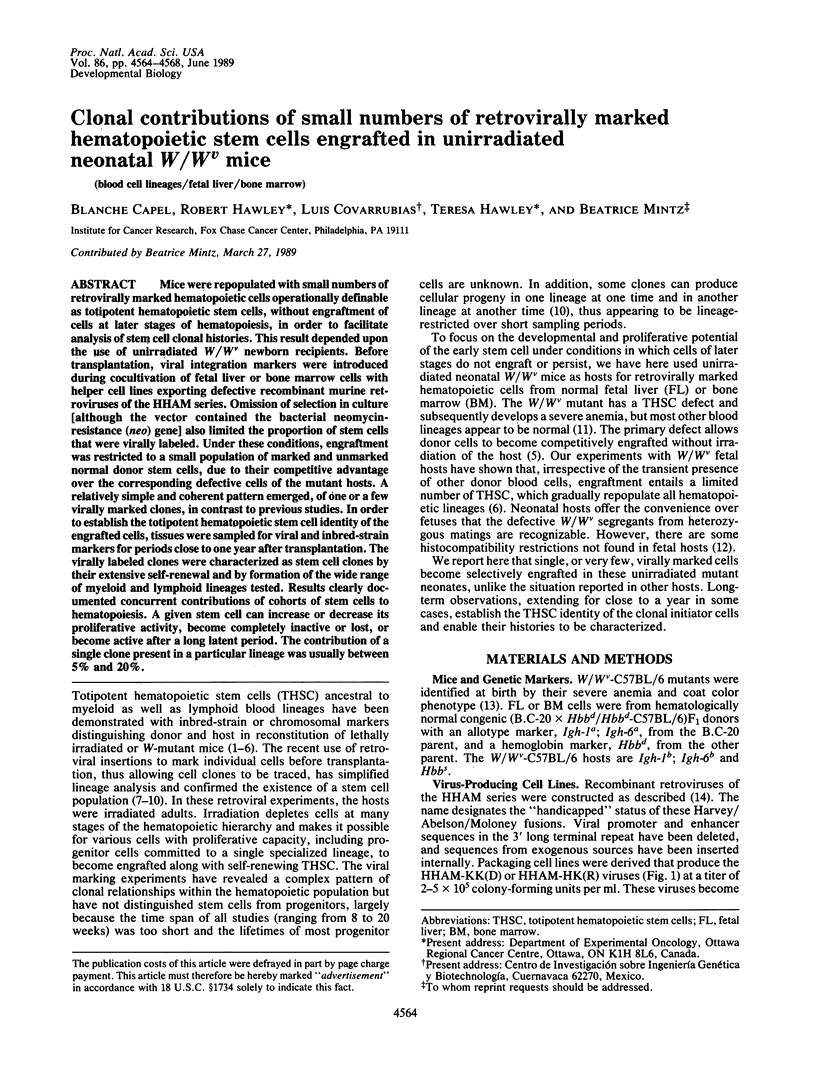
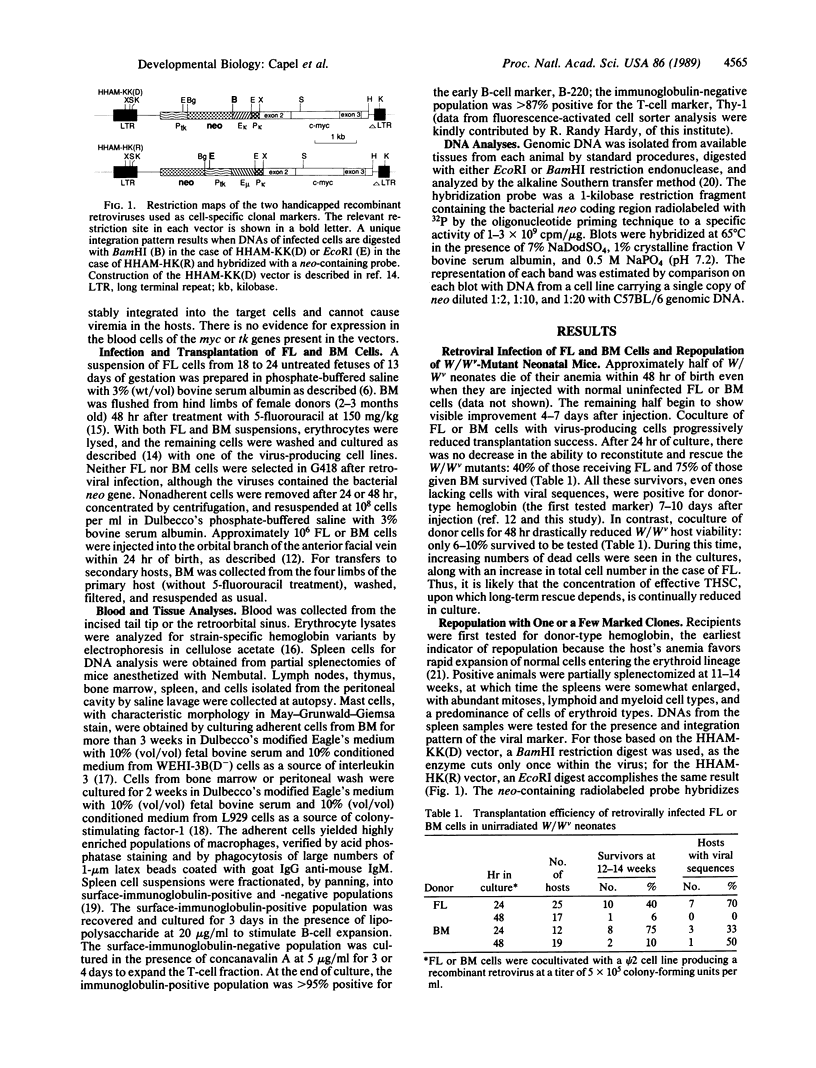
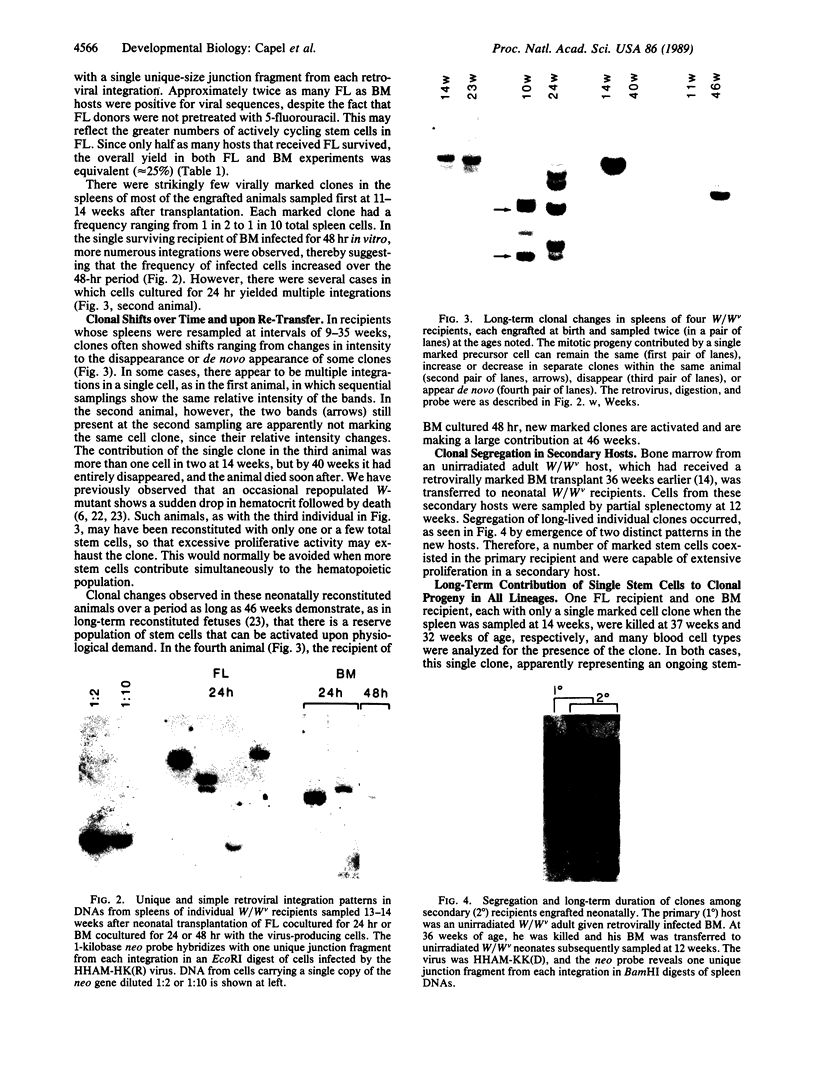
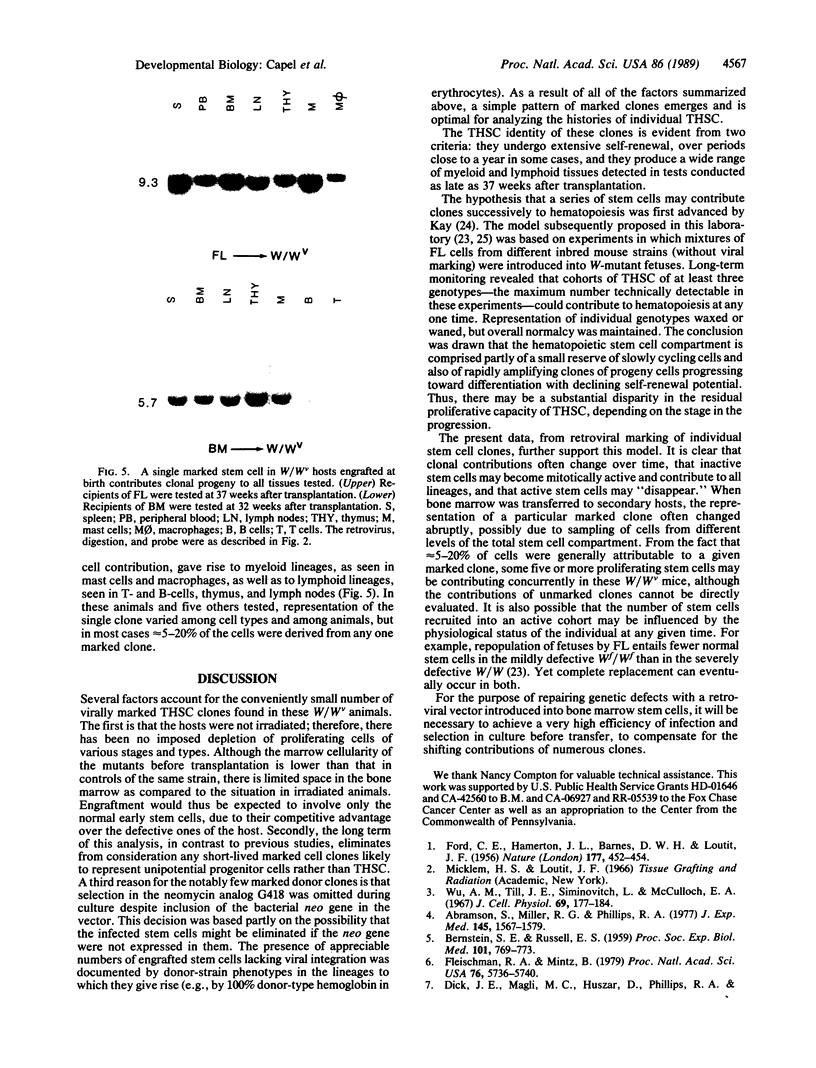
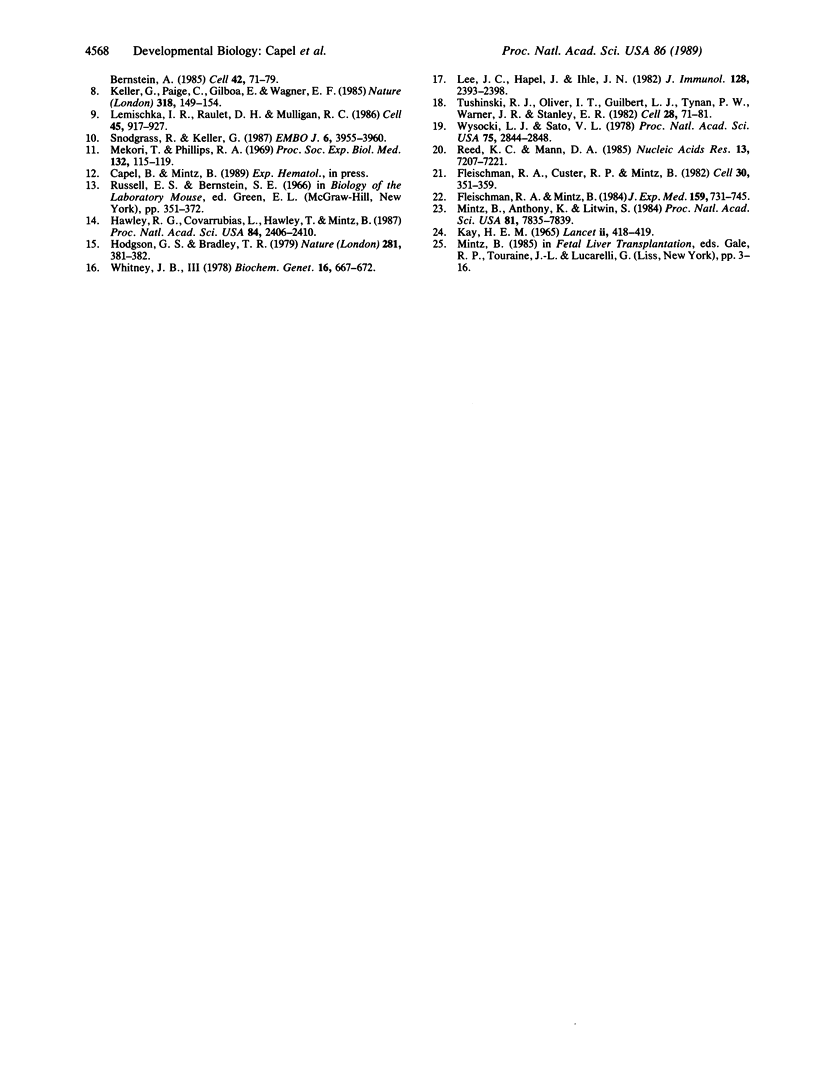
Images in this article
Selected References
These references are in PubMed. This may not be the complete list of references from this article.
- Abramson S., Miller R. G., Phillips R. A. The identification in adult bone marrow of pluripotent and restricted stem cells of the myeloid and lymphoid systems. J Exp Med. 1977 Jun 1;145(6):1567–1579. doi: 10.1084/jem.145.6.1567. [DOI] [PMC free article] [PubMed] [Google Scholar]
- BERNSTEIN S. E., RUSSELL E. S. Implantation of normal bloodforming tissue in genetically anemic mice, without x-irradiation of host. Proc Soc Exp Biol Med. 1959 Aug-Sep;101:769–773. doi: 10.3181/00379727-101-25089. [DOI] [PubMed] [Google Scholar]
- Dick J. E., Magli M. C., Huszar D., Phillips R. A., Bernstein A. Introduction of a selectable gene into primitive stem cells capable of long-term reconstitution of the hemopoietic system of W/Wv mice. Cell. 1985 Aug;42(1):71–79. doi: 10.1016/s0092-8674(85)80102-1. [DOI] [PubMed] [Google Scholar]
- FORD C. E., HAMERTON J. L., BARNES D. W., LOUTIT J. F. Cytological identification of radiation-chimaeras. Nature. 1956 Mar 10;177(4506):452–454. doi: 10.1038/177452a0. [DOI] [PubMed] [Google Scholar]
- Fleischman R. A., Custer R. P., Mintz B. Totipotent hematopoietic stem cells: normal self-renewal and differentiation after transplantation between mouse fetuses. Cell. 1982 Sep;30(2):351–359. doi: 10.1016/0092-8674(82)90233-1. [DOI] [PubMed] [Google Scholar]
- Fleischman R. A., Mintz B. Development of adult bone marrow stem cells in H-2-compatible and -incompatible mouse fetuses. J Exp Med. 1984 Mar 1;159(3):731–745. doi: 10.1084/jem.159.3.731. [DOI] [PMC free article] [PubMed] [Google Scholar]
- Fleischman R. A., Mintz B. Prevention of genetic anemias in mice by microinjection of normal hematopoietic stem cells into the fetal placenta. Proc Natl Acad Sci U S A. 1979 Nov;76(11):5736–5740. doi: 10.1073/pnas.76.11.5736. [DOI] [PMC free article] [PubMed] [Google Scholar]
- Hawley R. G., Covarrubias L., Hawley T., Mintz B. Handicapped retroviral vectors efficiently transduce foreign genes into hematopoietic stem cells. Proc Natl Acad Sci U S A. 1987 Apr;84(8):2406–2410. doi: 10.1073/pnas.84.8.2406. [DOI] [PMC free article] [PubMed] [Google Scholar]
- Hodgson G. S., Bradley T. R. Properties of haematopoietic stem cells surviving 5-fluorouracil treatment: evidence for a pre-CFU-S cell? Nature. 1979 Oct 4;281(5730):381–382. doi: 10.1038/281381a0. [DOI] [PubMed] [Google Scholar]
- KAY H. E. HOW MANY CELL-GENERATIONS? Lancet. 1965 Aug 28;2(7409):418–419. doi: 10.1016/s0140-6736(65)90763-4. [DOI] [PubMed] [Google Scholar]
- Keller G., Paige C., Gilboa E., Wagner E. F. Expression of a foreign gene in myeloid and lymphoid cells derived from multipotent haematopoietic precursors. Nature. 1985 Nov 14;318(6042):149–154. doi: 10.1038/318149a0. [DOI] [PubMed] [Google Scholar]
- Lee J. C., Hapel A. J., Ihle J. N. Constitutive production of a unique lymphokine (IL 3) by the WEHI-3 cell line. J Immunol. 1982 Jun;128(6):2393–2398. [PubMed] [Google Scholar]
- Lemischka I. R., Raulet D. H., Mulligan R. C. Developmental potential and dynamic behavior of hematopoietic stem cells. Cell. 1986 Jun 20;45(6):917–927. doi: 10.1016/0092-8674(86)90566-0. [DOI] [PubMed] [Google Scholar]
- Mekori T., Phillips R. A. The immune response in mice of genotypes W-Wv and Sl-Sld1. Proc Soc Exp Biol Med. 1969 Oct;132(1):115–119. [PubMed] [Google Scholar]
- Mintz B., Anthony K., Litwin S. Monoclonal derivation of mouse myeloid and lymphoid lineages from totipotent hematopoietic stem cells experimentally engrafted in fetal hosts. Proc Natl Acad Sci U S A. 1984 Dec;81(24):7835–7839. doi: 10.1073/pnas.81.24.7835. [DOI] [PMC free article] [PubMed] [Google Scholar]
- Reed K. C., Mann D. A. Rapid transfer of DNA from agarose gels to nylon membranes. Nucleic Acids Res. 1985 Oct 25;13(20):7207–7221. doi: 10.1093/nar/13.20.7207. [DOI] [PMC free article] [PubMed] [Google Scholar]
- Snodgrass R., Keller G. Clonal fluctuation within the haematopoietic system of mice reconstituted with retrovirus-infected stem cells. EMBO J. 1987 Dec 20;6(13):3955–3960. doi: 10.1002/j.1460-2075.1987.tb02737.x. [DOI] [PMC free article] [PubMed] [Google Scholar]
- Tushinski R. J., Oliver I. T., Guilbert L. J., Tynan P. W., Warner J. R., Stanley E. R. Survival of mononuclear phagocytes depends on a lineage-specific growth factor that the differentiated cells selectively destroy. Cell. 1982 Jan;28(1):71–81. doi: 10.1016/0092-8674(82)90376-2. [DOI] [PubMed] [Google Scholar]
- Whitney J. B., 3rd Simplified typing of mouse hemoglobin (Hbb) phenotypes using cystamine. Biochem Genet. 1978 Aug;16(7-8):667–672. doi: 10.1007/BF00484723. [DOI] [PubMed] [Google Scholar]
- Wu A. M., Till J. E., Siminovitch L., McCulloch E. A. A cytological study of the capacity for differentiation of normal hemopoietic colony-forming cells. J Cell Physiol. 1967 Apr;69(2):177–184. doi: 10.1002/jcp.1040690208. [DOI] [PubMed] [Google Scholar]
- Wysocki L. J., Sato V. L. "Panning" for lymphocytes: a method for cell selection. Proc Natl Acad Sci U S A. 1978 Jun;75(6):2844–2848. doi: 10.1073/pnas.75.6.2844. [DOI] [PMC free article] [PubMed] [Google Scholar]







